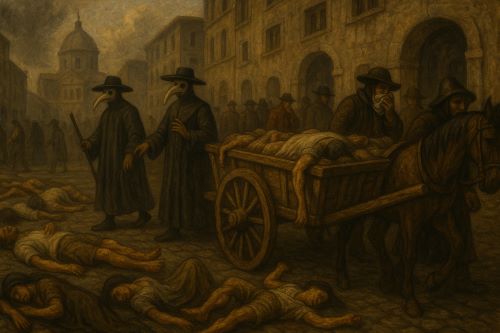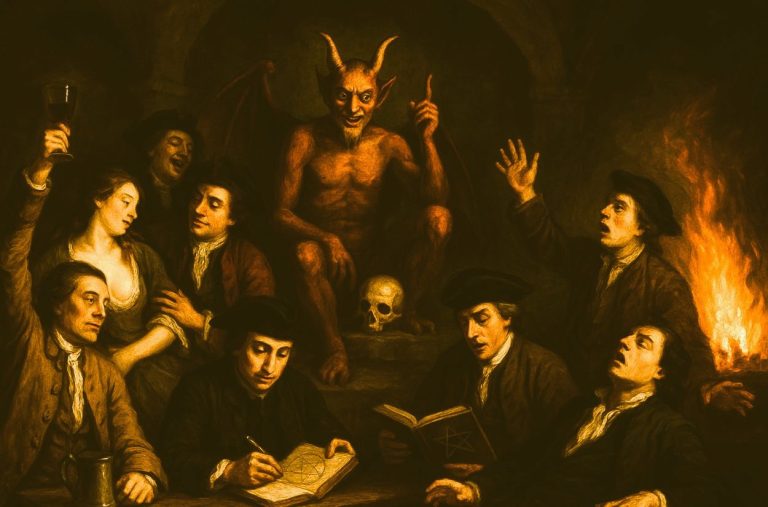

To understand this plague is not to isolate a pathogen but to examine a system – of commerce, of ambition, of governance – through the vector of contagion.

By Matthew A. McIntosh
Public Historian
Brewminate
Introduction: An Empire’s Decay in a Merchant’s Breath
When the Grand-Saint-Antoine docked in the bustling port of Marseille in May 1720, it carried more than silks and cottons from the Levant. Unseen among its cargo lurked death. In the humid hold, in the worn cloth, and perhaps even in the breath of a sailor who would not live another week, the bacterium Yersinia pestis had traveled the Mediterranean once again. This was not a medieval visitation, not the fourteenth century. This was Enlightenment France, a kingdom of encyclopedias, academies, and growing mercantile pride. Yet Marseille, a city tied by trade to the wider world, found itself seized by a disease believed long banished to the barbarous margins of empire.
The Great Plague of Marseille from 1720 to 1722 killed nearly half the city’s population and brought commercial France to the edge of catastrophe. Its origins were rooted in the porous nature of quarantine, the political weight of commerce, and the moral limits of state capacity. It unfolded not in some distant outpost but in one of the most vibrant economic centers of early modern Europe. What occurred was not only an epidemiological crisis but a civic and moral drama in which bodies, markets, and memories converged under the sign of pestilence.
Setting the Stage: Enlightenment and Epidemic
By the early eighteenth century, Marseille had become one of France’s most important trading hubs. Its privileged status under royal charter allowed it to serve as a gateway to the Levant and North Africa. The port’s prosperity relied on swift trade, and the administrative structure reflected that ambition. A Board of Health (Bureau de Santé) had been established in the previous century, designed to enforce quarantine and inspect incoming ships.
In theory, Marseille was prepared. It had a sophisticated surveillance system, a lazaretto on the Île de Jarre, and municipal authority empowered to act in emergencies. Yet theory faltered in the face of profit. The Grand-Saint-Antoine, returning from a lucrative trading voyage, was suspected of carrying plague. Several sailors had died en route, and the ship was required by law to observe quarantine. However, the pressure to offload its valuable cargo before the upcoming fair in Beaucaire overcame caution. Exceptions were made. Inspections were cursory. Bureaucratic self-interest, economic urgency, and personal ambition colluded in silence.1
By late June, unexplained deaths were reported in the poorer quarters of the city. Within weeks, the corpses were too many to bury.
The Plague Unleashed: Patterns of Contagion

The plague struck with characteristic brutality. Reports describe fever, delirium, buboes, and death within forty-eight hours.2 Physicians, many of them fleeing the city, debated whether the disease was truly plague or a lesser contagion. The question was not only medical but political. To name it “plague” would invoke the full apparatus of containment, disrupt trade, and tarnish Marseille’s reputation.
In this ambiguity, the disease flourished. Markets remained open too long. Ships continued to move. Funerals were held in secret to avoid quarantine. As bodies piled up, fear became general.
The patterns of mortality revealed the social stratification of the city. The poor, who lived in dense housing near the port, died in greatest numbers. The wealthy either fled or retreated to their estates in the surrounding countryside. Yet death was not entirely selective. Clerics, doctors, magistrates, even members of the city council succumbed. Civic order teetered.
Into the breach stepped the Chevalier Roze, a naval officer appointed to restore control. He organized mass burials, cleared corpses from the streets, and enforced sanitation with brutal efficiency. His role, later mythologized, reflected a broader Enlightenment tension: the search for rational public order amidst the irrationality of nature.3
Civic Response and the Limits of the State

The French crown, wary of panic spreading through the kingdom, responded cautiously. Troops were deployed to cordon off Marseille from the rest of Provence. Trade with the city was suspended, and neighboring towns enforced their own quarantines, sometimes violently.
Royal edicts reaffirmed public health measures, but implementation remained local. The centralized state, so often imagined as omnipotent in the age of absolutism, revealed its limits. Provincial authorities bore the brunt of logistics, sanitation, and security. Funding was inconsistent. Resources were stretched.
Still, the machinery of Enlightenment governance was not entirely paralyzed. Medical reports were compiled. Epidemiological records were kept. Corpses were counted. The Board of Health, after its initial failure, reasserted itself with harsh resolve. Quarantine was renewed. The lazaretto system was reinforced.
The state did not collapse. It adapted. But the adaptation came at the cost of thousands of lives and the transformation of Marseille from a port of vitality to a necropolis.
The Aftermath: Memory, Mourning, and Modernity

By the end of 1722, the epidemic had burned itself out. The city, though profoundly wounded, did not die. It rebuilt. Trade resumed. Yet the scars endured, not only in demographic terms but in the social fabric.
Art and literature responded swiftly. Engravings of plague carts and funerals circulated across Europe. Sermons cast the disaster in providential terms, while others blamed human greed, especially the merchant elite who had pressured officials to relax quarantine. A sense of civic failure lingered, tempered only by the heroism attributed to figures like Roze and Bishop Belsunce, who remained in the city ministering to the sick.4
The narrative of the plague became part of Marseille’s identity. It was not forgotten. Commemorations were held. Chapels were dedicated. The event shaped urban policy for a century. It prompted reforms in health infrastructure, including more rigorous quarantine enforcement, better reporting protocols, and greater oversight of maritime commerce.
In a larger sense, the plague of 1720 was a prelude to the modern biopolitical state. It forced questions about surveillance, responsibility, and the balance between individual liberty and collective safety. These were not merely eighteenth-century concerns. They resonate still.
Conclusion: History in the Plague’s Breath
The Great Plague of Marseille was neither an accident of bad luck nor a medieval throwback. It was an event deeply embedded in the economic, political, and ideological structures of its time. It revealed the vulnerabilities of Enlightenment society at precisely the moment it proclaimed mastery over nature.
Trade networks that enriched the city also betrayed it. Rational governance that promised safety hesitated under pressure. Social hierarchies that defined early modern cities shaped not only who lived but who died.
To understand this plague is not to isolate a pathogen but to examine a system – of commerce, of ambition, of governance – through the vector of contagion. Marseille’s tragedy was not unique. But its story, told in the shadow of Enlightenment confidence, remains singular. In the gap between ideals and bodies, history breathes.
Appendix
Footnotes
- Jean-Noël Biraben, Les hommes et la peste en France et dans les pays européens et méditerranéens, vol. 2 (Paris: Mouton, 1975), 422.
- Bernard Montfaucon, Diarium Italicum (Paris: Pierre-Guillemot, 1721), 113.
- Charles de Lorme, Mémoire sur les causes de la contagion (Marseille: Imprimerie Royale, 1723), 76.
- Michel Signoli et al., “Plague and Burial Practices in Early Modern Marseille,” Emerging Infectious Diseases 8, no. 4 (2002): 481–485.
Bibliography
- Biraben, Jean-Noël. Les hommes et la peste en France et dans les pays européens et méditerranéens. Vol. 2. Paris: Mouton, 1975.
- De Lorme, Charles. Mémoire sur les causes de la contagion. Marseille: Imprimerie Royale, 1723.
- Montfaucon, Bernard. Diarium Italicum. Paris: Pierre-Guillemot, 1721.
- Signoli, Michel, et al. “Plague and Burial Practices in Early Modern Marseille.” Emerging Infectious Diseases 8, no. 4 (2002): 481–485.
Originally published by Brewminate, 07.21.2025, under the terms of a Creative Commons Attribution-NonCommercial-NoDerivatives 4.0 International license.


